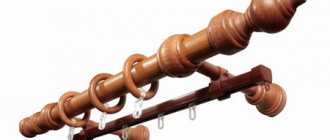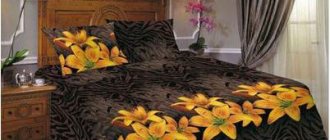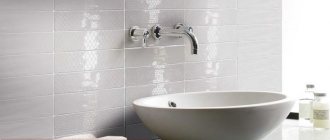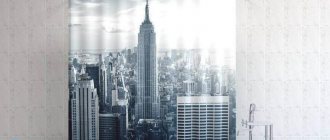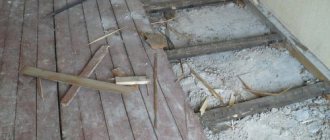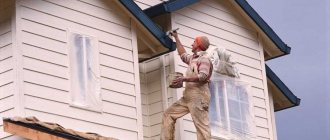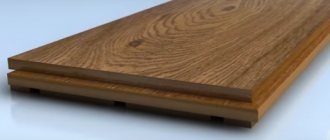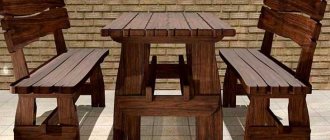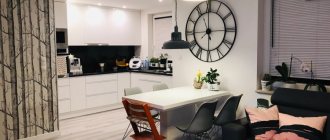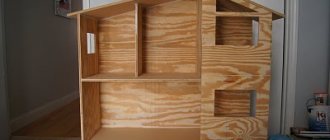Solid oak floors have always been considered a sign of respectability of the owner. The construction market is now overflowing with various types of exotic wood, the price of which is sometimes several times higher than the cost of proven, reliable oak.
But few people know that not all types of wood are suitable for our climate with humid, hot summers and dry, frosty winters.
Photo of an oak floor.
Features of solid oak
Oak floors are time-tested, it’s not for nothing that products made from this noble wood have been popular for centuries.
Traditions do not change, oak was, is and will remain the most popular material in its price niche.
- Solid oak boards are currently inferior in price to some types of artificial parquet, but significantly superior to them in quality.
- The service life of this material is 2 times higher than that of its artificial analogues.
- Over time, the coating does not lose color, does not fade and has high wear resistance.
Natural product
- Even if the floor is not varnished or painted, its surface practically does not lose its aesthetic qualities and mechanical stability.
- Such coatings can be repaired much easier, faster and cheaper than parquet.
- This coating is resistant to sharp heels or heavy furniture, so it can be laid in restaurants, conference rooms or other public spaces.
- And most importantly, oak itself is pleasant and beautiful; it radiates gentle natural warmth.
Oak floorboard.
Board dimensions
- The thickness of the floorboard traditionally ranges from 15 to 50 mm. The most popular boards are 15 - 22 mm thick. From 28 mm and above they are taken less frequently, although they are considered more durable and of higher quality.
- The width of the floorboards ranges from 60 to 450 mm. But the most popular boards are 60; 80; 100; 120 mm. This is due to the fact that a narrow board is easier to install, plus wide floorboards are more problematic when deformed and replaced. Although a wide board visually makes the room more spacious, a narrow board makes the room appear longer.
- In terms of length, the most common range is from 0.5 to 3 m. There are specimens up to 9m, but extremely rarely, because they are difficult to pack, transport and there is more waste during installation.
Sizes vary
Selection
This concept means the division of wood by color, texture, pattern, presence of mottled spots or knots.
All this depends on the cut of the wood and, although manufacturers share many options, 3 are classically generally accepted.
- Radial is a cut made along the central part of the trunk. This material has a uniform pattern and solid color. Its price is the highest, since it is considered the most durable and cannot be deformed.
- A cut slightly removed from the middle is called tangential. Its color spread is somewhat larger and may have different shades from the middle to the edge. Knots are allowed. This type of forest is valued for its wavy pattern.
- Rustic cutting has the most affordable price, but any variation in color is allowed here and there are no restrictions on the number and size of knots.
Marble floor
Many people associate marble with wealth and luxury. It is considered one of the most affordable stones for decorating residential premises. But before you begin installing marble floors, you need to weigh all the pros and cons of this coating.
The benefits are as follows:
- Wide choice of colors. Marble comes in white, grey, pink, beige and green. It is perfect for decorating a bathroom. It is impossible to confuse this stone with others. A distinctive feature of marble is the white veins on the surface and inside it.
- Marble floors look expensive, elegant and attractive. Meanwhile, the stone is affordable.
Marble floor
Unfortunately, there are many more disadvantages to finishing floors with marble than advantages.
- Marble has a soft structure. It is susceptible to staining, staining and surface etching.
- The stone requires careful care.
Despite a number of requirements, with proper care and use, marble will last a long time.
Laying technology
Let's prepare everything you need - and go!
Before starting work
- Naturally, the first thing you should pay attention to before laying an oak floor is the base. The base can be a slab flooring made from chipboard, OSB or thick plywood. Ordinary wooden joists. Or cement screed. We'll touch on each option.
- What all options have in common is that the base must be perfectly flat, horizontal, clean and dry. This is especially true for cement floor screed; its humidity should not exceed 4%.
Level the surface to perfection
- Before installation, you should unpack the material and leave it in the room where installation is planned for at least a week to adapt to the environment.
Important: solid oak flooring is strictly not recommended for use as a finishing coating for underfloor heating systems.
Laying on slab flooring
Now this type of installation is the most common, since oak flooring is expensive and the thicker the floorboards, the higher the price. And on a slab flooring you can lay thin, relatively inexpensive boards, plus it is very easy to lay oak floors on such a base with your own hands.
You only need material and tools, and instructions are given below.
Laying on slabs.
- First, pay attention to the damper gap; it is necessary for any type of flooring; for oak, 10 mm is enough. As a rule, when installing slab flooring, a damper tape is installed; it is quite sufficient.
- The boards are connected using the tongue-and-groove principle. The first row is laid in the direction of the groove towards the wall and is fastened on top near the wall with a self-tapping screw, which is subsequently covered with a plinth.
- On the opposite side of the board, in the upper corner above the tenon, at an angle of 45 - 50˚, a through hole is drilled. Through it, with a self-tapping screw, the bar is attached to the base. The screw itself will be covered with the next strip.
- You can assemble it differently: turn the tenon towards the wall, fix it with a self-tapping screw, and then, using special metal brackets, assemble the rest of the structure and fix it to the base.
- When installing a solid oak floor on a slab flooring, we do not recommend installing it with glue, since later, if repairs are necessary, disassembling it will be problematic.
Laying diagram.
Laying on joists
Laying on joists is also not difficult. But this option is usually used for thick boards. So, for example, if the span between the joists is 60 cm or more, then the board should have a thickness of at least 40 - 45 mm. But such floors are considered the most durable.
The principle of laying on logs.
The whole principle of installation is similar to installation on a slab flooring, only the boards are attached with self-tapping screws to the joists.
Laying on screed
This type of installation is less common, but it can be laid on the screed in 2 ways.
- Cover the concrete screed in several layers with synthetic soil and let it dry thoroughly. Next, apply two-part synthetic parquet adhesive with a notched trowel and lay the oak floor.
- This method is also called floating. First, it is advisable to apply primer, then lay a backing in the form of foamed polyethylene; you can use foamed polyethylene covered with foil. Next, apply the first strip to the stop of the damper gap and tightly, using a locking connection, assemble the entire structure.
Important: if you choose a method in which the planks are glued to the base, you should not immediately mix a large amount of glue, it hardens quickly.
Properties of parquet boards
The design of the parquet board ensures its high performance and aesthetic characteristics. It is characterized by very high strength, resistance to changes in temperature and humidity. Parquet boards are quite difficult to damage using rough mechanical influences; chips from impacts very rarely occur on them. That is why parquet boards are used for flooring in a wide variety of rooms, including those with rather harsh operating conditions.
Parquet boards are easy to install and maintain (especially with a varnished top layer) and have an excellent appearance. Depending on the type of wood used to create the top layer of wood, a parquet board can have a very diverse appearance, but the parquet board is always distinguished by the highest aesthetics. An important condition for the normal operation of parquet flooring is its laying on a level, well-prepared base.
Interesting trivia
- Oak lends itself very well to tinting, and the color lasts well; this feature is often used by unscrupulous manufacturers. They take oak, subject it to special processing and sell it as an expensive exotic wood.
- With factory varnishing, the varnish on the board will never crack, but it will not be possible to achieve a perfectly flat surface; the joints on the plane will be visible.
- A bleached oak floor in an interior with a predominance of light colors will look ideal, but it is better to varnish it, since the natural solid wood will easily get dirty.
Bleached oak with revealed structure.
- One of the best options is an oil-coated board; its price is quite reasonable and its appearance is very decent. The only negative is that once every six months the oak floor covered with oil needs to be rubbed with mastic.
- When purchasing solid oak flooring, pay attention to the packaging. Such expensive material is usually packaged in corrugated hard cardboard and sealed in thermal film. If you are offered an unpacked board from an unclear warehouse, you should think twice.
Review of popular flooring for children's rooms
Cork material is one of the most purchased coatings today when replacing flooring in a children's room. It is environmentally friendly and soft, ideal for a children's room.
But when choosing this material for yourself, you need to remember that in our time too many fake raw materials are sold on the building materials market.
This way you can really buy high-quality flooring, but you may end up with an ordinary fake. In this case, there will be no end to your disappointment, because the floor you re-laid will not last two or three years.
